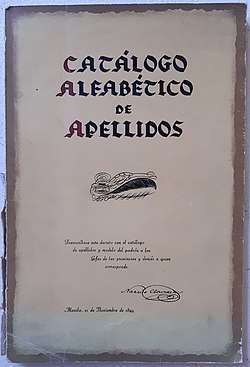Narciso Clavería y Zaldúa
This article may require cleanup to meet Wikipedia's quality standards. The specific problem is: NPOV issues. (December 2015) |
Isabella II of Spain | |
|---|---|
| Preceded by | Francisco de Paula Alcalá de la Torre |
| Succeeded by | Antonio María Blanco |
| Personal details | |
| Born | Narciso José Anastasio Clavería y Zaldúa May 2, 1795 Girona, Catalonia, Spain[1] |
| Died | June 20, 1851 (aged 56) Madrid, Spain |
| Spouse(s) | Ana Berroeta Clavería, Countess of Manila[2] |

Narciso José Anastasio Clavería y Zaldúa, 1st Count of Manila (Catalan: Narcís Josep Anastasi Claveria i Zaldua; May 2, 1795[1] – June 20, 1851) was a Spanish army officer who served as the Governor-General of the Philippines from July 16, 1844, to December 26, 1849.
Clavería is widely recognized as a reformist and modernizing administrator. He traveled through many provinces trying to learn the needs of Filipinos. He encouraged agriculture, improved the streets and suburbs of Manila, and succeeded in helping the country.[3] He was given the title Count of Manila.[2][4] The towns of Claveria in Misamis Oriental province, Claveria in Masbate province, and Claveria in Cagayan province were named in his honor.[5]
His grandson,
Early years
Narciso Clavería was a native of the
Acts as Governor-General of the Philippines
Reformation of the Philippine calendar
The
Surnames for Filipinos
From the days of the Spanish conquest, some Filipinos had received Spanish surnames. Most people, however, had no surnames, which caused confusion. On Wednesday, November 21, 1849, Clavería issued a decree sending long lists of Spanish and local surnames to the chiefs of the provinces. These were sent out to the different towns, and given to the locals who had no surnames. In many towns, all the names for people in that town began with the same letter of the alphabet.[3] For instance, surnames starting with "A" applies for those who lived in Alimodian while those starting "M" apply for those who lived in Miagao.
First steamships in the Philippines
The first
Spanish expedition to Balanguingui
Clavería organised an
Reforming the governors of the provinces
From the earliest days, the chief of a
Clavería mandated that the governors should not engage in trade. This decree was not fully obeyed for many years after the time of Clavería. At that time there were thirty-one provinces. The governor received a salary of from three hundred to two thousand Philippine pesos a year. The most common salary was six hundred pesos. In return for the privilege of controlling the trade of the provinces the governors paid the government as high as three thousand pesos a year. Yet they usually became rich. Men of high position tried to get these places. Sometimes they returned to Spain with fortunes, after a few years as governor. Often these fortunes were made by dealing unjustly or because of the monopoly they exerted in certain areas.[3]
Other acts during his term
A casino called "Sociedad de recreo" (" Recreation Association ") was established on Thursday, October 31, 1844. His proposal to establish military library was approved on Sunday, February 15, 1846. A monument to
Return to Spain
In 1849, Clavería requested that he be allowed to retire. After which he left the position of governor-general and returned to Spain.[8] He was a man of culture, probity, and industry.[3] He was made a senator in 1850 but died the following year on June 20 in Madrid.[6][9]
References
- ^ a b Baptismal record of Narciso Clavería
- ^ a b "Repertorio General. Indice Alfabetico de los principales vecinos de Madrid con indicacion de sus domicilios", p.115. Imprenta de J. Martin Alegria, Madrid, 1852.
- ^ a b c d e f g h Jernegan, Prescott Ford (1905) "A short history of the Philippines: for use in Philippine schools". pp. 232-234. D. Appleton and Company, New York.
- Gaceta de Madrid. no. 4980, May 3, 1848, pg. 2. (BOE-A-1848-2189)
- ^ a b (2009-03-28). "Brief History of Claveria" Archived July 13, 2011, at the Wayback Machine. Lakay-Lakay, Official Claveria Website. Retrieved on June 3, 2011.
- ^ a b Ruiz, Angel Salcedo (1914). "Historia de España", p.715. Saturnino Calleja Fernandez, Madrid.
- ^ Joel (August 27, 2007). "Missing Date in Philippines History: 31 December 1844". Far Outliers. Retrieved March 7, 2022.
- ^ a b c Blair, Emma Helen and Robertson, James Alexander (1904). "The Philippine Islands 1493-1803, Vol.17", pp. 304-305. The Arthur H. Clark Co., Cleveland, OH.
- ^ "Ficha". Archived from the original on June 18, 2010. Retrieved July 26, 2012.
External links
- Narciso de Clavería Zaldúa Archived February 22, 2012, at the Wayback Machine from Universidad Complutense de Madrid


